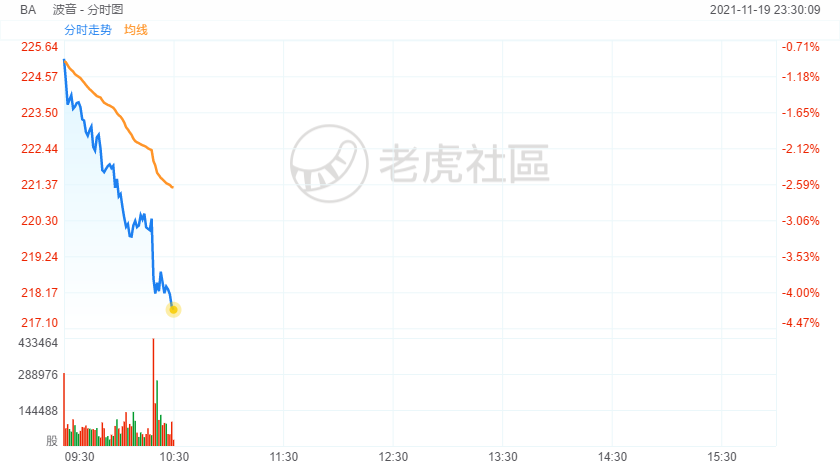Boeing stock dropped 4% in morning trading as Boeing Dreamliner defected bog down production.
Boeing Co. has further slowed production of 787 Dreamliners as it addresses defects that are delaying deliveries of new jets and complicating airlines’ plans, people familiar with the matter said.
The plane maker is holding off completing the new wide-body jets at its North Charleston, S.C., factory as workers and engineers address problems related to areas surrounding passenger and cargo doors on aircraft already under construction, these people said.
The latest production slowdown began in recent days and could last a few weeks as Boeing seeks expertise from other aerospace manufacturers in addressing the door issue, some of these people said. In late October, Boeing disclosed it was producing about two Dreamliners a month, down from a planned monthly rate of five,to resolve production issues.
A string of production snafus has hampered Boeing’s ability to deliver new Dreamliners for much of the last year, fueling the manufacturer’s financial losses and making it difficult for airlines to build schedules for jets often used in international travel. The plane maker has faced increased scrutiny internally, by air-safety regulators and lawmakers after two of its 737 MAX jets crashed in 2018 and 2019, claiming 346 lives.
A Boeing spokeswoman said work continues at its Dreamliner factory and production “rates will continue to be dynamic” as the manufacturer focuses on resuming normal assembly, performs inspections and repairs finished aircraft awaiting delivery.
Boeing is increasingly likely to restart handing over new Dreamliners to its customers in February or March at the earliest, longer than previously anticipated, people familiar with the matter said.
The company has been seeking Federal Aviation Administration approval for its proposed pre-delivery inspections to ensure new aircraft meet federal rules and match Boeing’s regulator-approved designs. An FAA spokesman said the agency won’t sign off on inspections until its safety experts are satisfied.
“This is a case of us looking at every single aspect of design and manufacturing with the airplane, making sure that we’re complying, we’re conforming to the design and we will bring that airplane back as soon as that makes sense,” Ihssane Mounir, Boeing’s commercial sales chief, said Nov. 13 at an air show in Dubai.
In an Oct. 27 call with analysts, Chief Executive David Calhoun said defective titanium parts were the “long pole in the tent” among remaining production problems to address.
The door issue has since emerged as the most vexing among Boeing’s 787 problems, people familiar with the matter said. Other defects being addressed are related to items such as certain aluminum parts and windows, some of these people said. Boeing has largely been dealing with tiny gaps where sections of the aircraft join together. Such gaps could lead to premature fatigue that may require repairs sooner than anticipated.
The Boeing spokeswoman said the company is confident its approach would lead to stability in its 787 production. “We are taking the time needed to ensure the highest levels of quality,” she said.
None of the defects being addressed pose immediate safety concerns with Dreamliners currently flying, the Boeing spokeswoman said.
With deliveries largely halted since October 2020, the Chicago-based aerospace giant said it had built up an inventory of 105 Dreamliners as of the end of the third quarter this year, according to securities filings. The undelivered jets are worth more than $25 billion.
The delivery halt has choked off an important source of cash flow for Boeing as it emerges from the coronavirus pandemic’s blow to aircraft demand. It is also complicating airlines’ plans as international travel rebounds. Dreamliners are Boeing’s flagship wide-body jets and are often used on long-haul flights.
American Airlines Group Inc. said it had trimmed its flying plans due to the delayed arrival of its new 787s.
“Due to the continued uncertainty in the delivery schedule, we have proactively removed these aircraft from our winter schedule to minimize potential passenger disruption,” Derek Kerr, the airline’s finance chief, said on an Oct. 21 earnings call.
The FAA launched a broad review of Boeing’s Dreamliner production in late 2020.
On Thursday, Democratic and Republican leaders of the U.S. House Transportation Committee and its aviation subcommittee requested that the Department of Transportation’s inspector general review the FAA’s manufacturing oversight and “the effectiveness of the FAA’s actions to resolve 787 production issues,” according to a letter reviewed by The Wall Street Journal.
Representatives of the DOT’s inspector general’s office didn’t immediately respond to requests for comment.

Comments